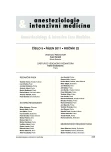Does measuring the intracranial pressure influence survival rates in patients with brain injury?
Authors:
Krbila Štefan 1; Soboňa Viliam 1; Waczulíková Iveta 2; Záhorec Roman 3
Authors‘ workplace:
KAIM FNsP Nové Zámky
1; Matematicko-fyzikálna fakulta Univerzity Komenského, Bratislava
2; II. KAIM LF UK a Onkologického ústavu sv. Alžbety v Bratislave
3
Published in:
Anest. intenziv. Med., 22, 2011, č. 5, s. 272-278
Category:
Intensive Care Medicine - Original Paper
Overview
Objective:
To compare the outcomes and mortality at 7 and 270 days in brain-injured patients with an inserted ICP sensor to those without an ICP sensor.
Type of study:
Prospective and comparative clinical study.
Materials and methods:
The study population, which consisted of 64 patients with brain injury, was divided into a group with continuous ICP monitoring for 7days and a group without ICP monitoring. The follow-up period was between 7 and 270 days. The recorded values and other relevant data were analysed by methods of descriptive and inductive statistics.
Results:
The differences between the groups in survival up to 7 and 30 days were not statistically significant (median survival = 30 days in both groups, P = 0.32). In the group with ICP monitoring, the values below 20 mm Hg were associated with a significantly reduced risk of death. The overall mortality rates within 30 days were not characterized by unusual survival distribution curves. In the period from the 30th up to the 270th day after injury there was a single death recorded.
Conclusion:
Trauma patients’ survival depends on the speed and quality of the pre-hospital care followed by adequate treatment in specialized centres. Mortality and survival up to 7 and 30 days were not significantly different between the groups, possibly due to a small sample size.
Keywords:
craniocerebral trauma – intracranial pressure monitoring – survival analysis – prediction of neurologic outcome
Sources
1. Lundberg, N. Continuous recording and control of ventricular fluid pressure in neurosurgical practice. Acta Psychol. Neur. Scand., 1960, 36, suppl., p. 1–193.
2. Bullock, M. R. for the Task Force Indications for intracranial pressure monitoring. In: Management and prognosis of severe traumatic brain injury – Part I.: Guidelines for the management of severe traumatic brain injury, J. Neurotrauma, 2007, 24, suppl. 1, p. 37–44.
3. Ghajar, J. Intracranial pressure monitoring techniques. New Horiz., 1995, 3, p. 395–399.
4. Mayhall, C. G., Archer, N. H. et al. Ventriculostomy – related infections: A propspective epidemiologic study. N. Engl. J. Med., 1984, 310, p. 553–559.
5. Martinez-Maňas, R. M, Santamaria, D. Intracranial pressure monitor: Prospective study of accuracy and complications. J. Neurol. Neurosurg. Psychiatry, 2000, 69, p. 82–86.
6. Guillame, J., Janny, P. Continuous intracranial manometry; physiopathologic and clinical significance of the method. Presse Med., 1951, 59, p. 953–955.
7. Patel, H. C., Boumra, O., Woodford, M., King, A. T., Yates, D. W., Lecky, F. E. Trends in head injury outcome from 1989 to 2003 and the effect of neurosurgical care: An observational study. Lancet, 2005, 366, p. 1538–1544.
8. Sahipaul, R., Girotti, M. Intracranial pressure monitoring in severe traumatic brain injury – results of Canadian survey. Can. J. Neurol. Sci., 2000, 27, p. 143–147.
9. Roukoz, B., Chamoun, M. D., Claudia, S., Robertson, M. D., Shankar, P., Gopinath, M. D. Outcome in patients with blunt head trauma and a Glasgow Coma Scale score of 3 at presentation. Clinical article J. Neurosurg., 2009, 111, p. 683–687.
10. Fearnside, M. R., Cook, R. J., McDougall, P., McNeil, R. J. The Westmead Head Injury Project outcome in severe head injury. A comparative analysis of pre-hospital, clinical and CT variables. Br. J. Neurosurg., 1993, 7, p. 267–279.
11. Tien, H. C., Cunha, J. R., Wu, S. N., Chughtai, T., Tremblay, L. N., Brenneman, F. D. et al. Do trauma patients with a Glasgow Coma Scale score of 3 and bilateral fixed and dilated pupils have any chance of survival? J. Trauma, 2006, 60, p. 274–278.
12. Kotwica, Z., Jakubowski, J. K. Head-injured adult patients with GCS of 3 on admission – who have a chance to survive? Acta Neurochir., 1995, 133, p. 56–59.
13. Waxman, K., Sundine, M. J., Young, R. F. Is early prediction of outcome in severe head injury possible? Arch. Surg., 1991, 126, p. 1237–1242.
Labels
Anaesthesiology, Resuscitation and Inten Intensive Care MedicineArticle was published in
Anaesthesiology and Intensive Care Medicine

2011 Issue 5
Most read in this issue
- Ultrasound guided medial cervical plexus blockade
- Does measuring the intracranial pressure influence survival rates in patients with brain injury?
- The mechanism of hypotension with intravenous paracetamol in the critically ill
- Fibrinolysis in cardiac surgery in the post-aprotinin era
